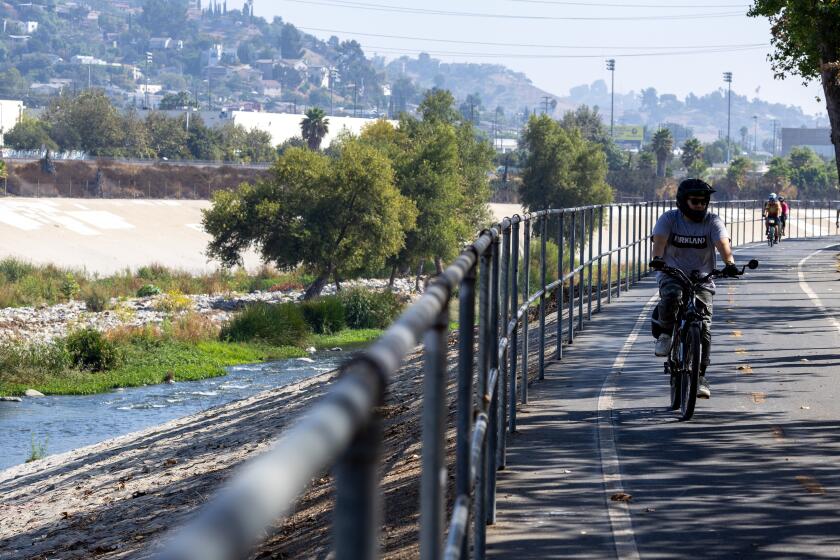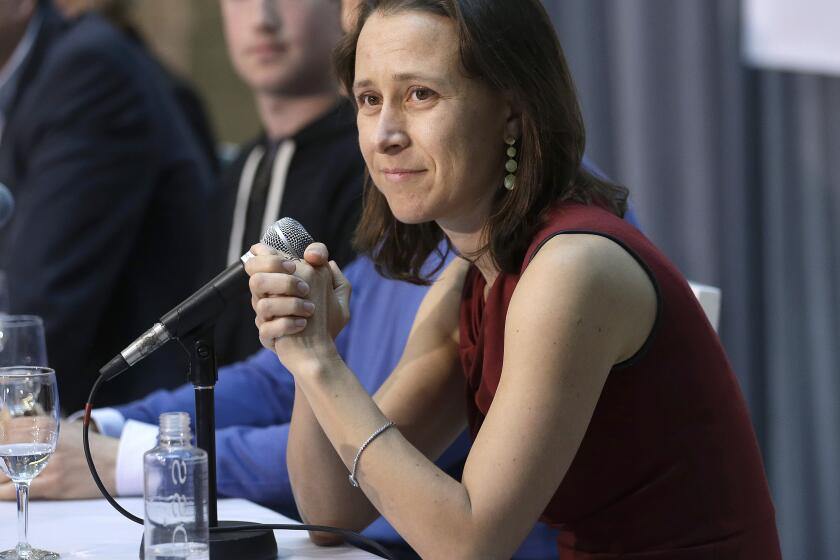Carmageddon’s untold benefits, and how to keep them
So it turns out that Carmageddon is good for us.
UCLA researchers on Friday released a study showing that last year’s Carmageddon -- a weekend closure of a 10-mile Westside stretch of the 405 Freeway, which, as you already know unless you’ve been underwater for the last month, is to be repeated this weekend -- dramatically improved air quality. With the reduction in traffic around the region as drivers stayed out of their cars to avoid anticipated gridlock that never materialized, air quality reached levels up to 83% better near the freeway and 75% better across the Westside.
And that has a lot of Angelenos, not just Westsiders, dreaming that impossible L.A. dream: What if we could do that all the time? What would it take?
The answers thrown out by dreamers and traffic experts are all terrific ideas, but from a practicality standpoint, they’re mostly pretty dreamy. For one thing, that stems from the fact that people can be persuaded to stay home or get around without a car for one inconvenient weekend, but you can’t get them to do it all the time. Nor would you want to; the economy depends to a large extent on mobility: the ability of people to get to their jobs, drive to stores and cart off merchandise, truck goods from the ports, etc. And a good part of the quality of life in Los Angeles is getting around town to enjoy the city’s many amenities.
The best of the dreamy ideas: Get more people to buy hybrid, electric and high-mileage cars. That’s going to happen automatically because of both high gas prices and tightening federal fuel economy standards, but meaningful change is going to take a very, very long time. Only a relatively small segment of the population can afford a new car at any given time, and they, in turn, sell or trade in their old, gas-guzzling cars, which are bought up and driven by less wealthy people rather than taken out of circulation.
Should we all live closer to work, shop locally, ride our bikes and walk more, or buy Vespas and become scooter commuters? Absolutely. Just don’t count on this happening on the scale needed to reduce traffic or pollution. For most people, these options are too expensive, too inconvenient, too physically demanding or too scary.
Ride more public transit? That would be ideal. But it’s not going to happen on a difference-making level until the incentives change: It has to be faster, and/or considerably cheaper, to get to one’s destination by bus or train than by car. For most Angelenos, that isn’t the case right now.
My two favorite solutions: Build more and better transit, particularly rail networks so that the speed/expense incentive shifts, and expand toll roads. Los Angeles County set out on the first path in 2008, when voters approved Measure R and agreed to hike local sales taxes to pay for more transit lines. The result, on the Westside, will be a subway running from Westwood to downtown and a light-rail line to the south of the subway running from Santa Monica through Culver City to USC to the downtown transit hubs. The good news is, the latter project, Expo Line Phase II, is already under construction and slated for completion in 2015. The faster and more desirable subway, though, doesn’t even have a projected completion date because it still doesn’t have all its funding in order; it should take at least a decade, probably more. That might change if voters approve Measure J in November, extending the sales tax past its current expiration date in 2039 so that transit officials can issue bonds against future revenue and build the Measure R projects sooner.
As for toll roads, their time hasn’t come in Los Angeles. Stretches of carpool lanes on the 10 and 110 freeways are being converted into toll lanes, but that’s a pretty small experiment, and, because they’re shared with carpoolers, these aren’t fully toll routes. A better option would be privately funded toll roads paid for by operators who would recoup their expenses via tolls. Some complain this would create an elitist, two-tiered system in which the wealthy could speed to their destinations while the poor stew in traffic, but that’s misguided. Without the private funding, the road wouldn’t exist at all, and roads and freeways everywhere would benefit from a reduction in traffic as some cars are diverted to the toll road. Moreover, less gridlock means less pollution, which benefits everybody. Orange County has a decent little network of toll routes, but then, the O.C. still had available land to build them. In overdeveloped Los Angeles, there aren’t many places to put a toll road without converting an existing public route, which would lead to a storm of controversy. It’s still a good idea, and it should be pursued wherever possible.
Meanwhile, back to Carmageddon II, which no one seems to be taking very seriously this time around after feeling burned by all the hype last year. It will be interesting to see whether that produces the kind of traffic nightmare people feared a year ago. If so, it will be a great indicator of how much of a difference our attitudes make when it comes to such practical matters as pollution and traffic.
The dreamiest solution of all, then, would be to permanently change people’s attitudes about driving.
OK, but seriously, there’s always Measure J...
ALSO:
Kinsley: The unsuccessful ethic of success
Follow Dan Turner on Facebook
More to Read
A cure for the common opinion
Get thought-provoking perspectives with our weekly newsletter.
You may occasionally receive promotional content from the Los Angeles Times.










